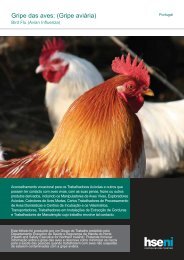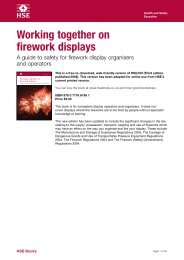The safe isolation of plant and equipment (HSG253) - Health and ...
The safe isolation of plant and equipment (HSG253) - Health and ...
The safe isolation of plant and equipment (HSG253) - Health and ...
You also want an ePaper? Increase the reach of your titles
YUMPU automatically turns print PDFs into web optimized ePapers that Google loves.
Appendix 4: Valve types <strong>and</strong><br />
issues<br />
<strong>Health</strong> <strong>and</strong> Safety<br />
Executive<br />
1 Table A outlines the characteristics <strong>of</strong> common valve types. Select <strong>isolation</strong><br />
valves carefully to ensure successful performance in service, based on <strong>isolation</strong><br />
circumstances. Key factors are:<br />
■<br />
■<br />
■<br />
sealing ability;<br />
security (potential for accidental or deliberate reopening); <strong>and</strong><br />
reliability (potential for partial or total loss <strong>of</strong> seal).<br />
2 Limitations on the use, for <strong>isolation</strong>, <strong>of</strong> valves with other primary functions<br />
include:<br />
■<br />
■<br />
■<br />
control or choke valves are not generally suitable for <strong>isolation</strong>;<br />
emergency <strong>isolation</strong> valves may be used for <strong>plant</strong> <strong>isolation</strong>, provided they are <strong>of</strong><br />
a suitable type for the fluid <strong>and</strong> conditions being isolated;<br />
relief valves should not be used unless there is a purpose-designed method <strong>of</strong><br />
securing the valve in the closed position <strong>and</strong> if it is possible to pressure test<br />
the valve to the maximum anticipated differential pressure in the direction <strong>of</strong> the<br />
applied pressure. Particular care is required to ensure proper reinstatement <strong>of</strong><br />
relief valves to their required operating status <strong>and</strong> correct set pressure.<br />
3 Valves are likely to provide a tight seal ‘on dem<strong>and</strong>’ only where you select:<br />
■<br />
■<br />
an appropriate type <strong>of</strong> valve; <strong>and</strong><br />
trim materials compatible with the process fluid conditions.<br />
4 Valve selection should take account <strong>of</strong> accumulated experience <strong>of</strong> a particular<br />
valve/trim combination performing satisfactorily under specific process conditions.<br />
5 Use commissioning tests to confirm the initial sealing performance <strong>of</strong> the<br />
installed valve.<br />
6 Prove the leak tightness <strong>of</strong> a valve every time it is used for <strong>isolation</strong>.<br />
7 Once a valve has been proven leak tight, the likelihood <strong>of</strong> a leak then<br />
developing during the <strong>isolation</strong> is low, but this could be an issue for long <strong>isolation</strong>s<br />
(eg greater than a month). In such situations, consideration should be given to the<br />
periodic testing <strong>of</strong> the upstream valve <strong>of</strong> the <strong>isolation</strong>.<br />
8 Careful consideration is required before using valves which provide a double<br />
seal in a single-valve body with a bleed in between (eg double-wedge gate, parallel<br />
exp<strong>and</strong>ing gate or double-seal ball valves) for <strong>isolation</strong>. In some applications,<br />
both barriers cannot be easily tested. Also, the security <strong>of</strong> the <strong>isolation</strong> depends<br />
upon the immobilisation <strong>of</strong> a single valve operating stem. Such valves should be<br />
used in preference to a double block <strong>and</strong> bleed <strong>isolation</strong> method only after full<br />
consideration <strong>of</strong> these increased risks.<br />
<strong>The</strong> <strong>safe</strong> <strong>isolation</strong> <strong>of</strong> <strong>plant</strong> <strong>and</strong> <strong>equipment</strong> Page 50 <strong>of</strong> 81







